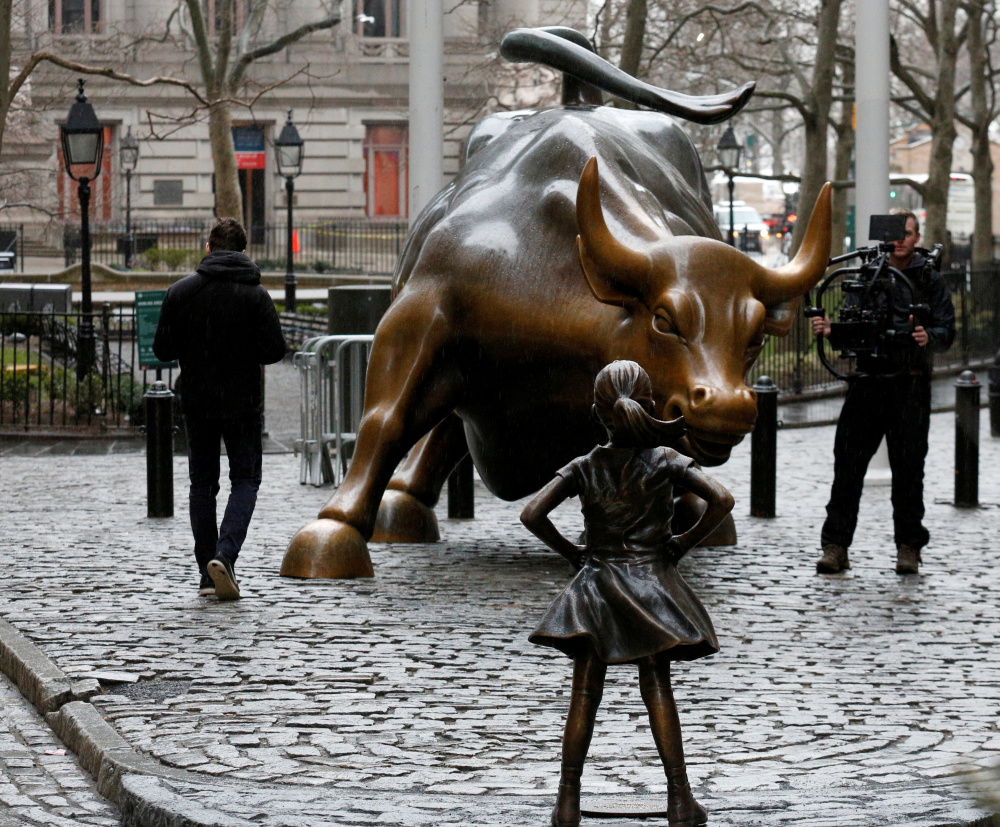NEW YORK — After the 1987 stock market crash, sculptor Arturo Di Modica spent two years and $300,000 secretly working on a gift he hoped would lift the spirits of a demoralized city. He deposited the 11-foot, 3-ton “Charging Bull” statue in front of the New York Stock Exchange in the middle of a wintry night.
Today, that icon of Wall Street prosperity is staring down another statue that has become a potent symbol in its own right – a petite girl in high-top sneakers. The “Fearless Girl,” fists curled at her sides and face held high in seeming defiance of the giant bull galloping before her, has drawn international attention since it was unveiled last month and tapped into growing frustration around the struggle female executives face rising into leadership positions, particularly on Wall Street.
Di Modica sees something else: Fearless Girl, he argues, has turned his bull into a symbol of male chauvinism. His attorneys said he may sue if the statue isn’t removed.
But the city isn’t budging, and the standoff has turned into a high-profile debate over the role of public art, intertwined with visceral feelings about Wall Street and the role of women.
The origins of the two works of art could not be more different. Fearless Girl belongs to one of the largest banks in the world, Boston-based State Street, which commissioned the work last year as part of an advertising campaign. The statue, the bank says, is part of an effort to use its financial might to encourage companies to put women in more prominent leadership positions. (It initially included a plaque that mentioned one of the bank’s funds.)
Di Modica says his statue was a work of conviction.
The 76-year-old gray-bearded sculptor has generated some sympathy, particularly from other artists. Gabriel Koren, whose bronze sculpture of Frederick Douglass looks into Harlem from Central Park, says she would be offended by another artist placing a competing piece of art near her creation without permission.
“Every sculpture needs space. That is the nature of sculpture,” she said. “If you put something else there, it changes it.” The Fearless Girl, she said, is “cute,” but “you don’t stand up for women’s rights at the expense of the artist’s rights. Each right is equally important. I am saying this as a woman.”
Yet others say the meaning of Di Modica’s bull began to change long before Fearless Girl arrived. During the height of the Occupy Wall Street protests, New York City police put barricades around the statue to protect it from demonstrators.
“Let’s be blunt, the Charging Bull is a celebration of unfettered capitalism,” New York Mayor Bill De Blasio said recently on the Brian Lehrer Show. “You could say it is about the spirit of optimism, sure – that’s what the artist was thinking, that’s great. But it is a symbol of Wall Street. And Wall Street, to say the least, is a double-edge sword.”
This comes as the financial industry struggles to shed its reputation as a boys club where women struggle to succeed. None of the country’s mega-banks, such as JPMorgan, Bank of America and Goldman Sachs, are led by women. Even State Street has been forced to acknowledge its own shortfalls – the bank has only three women on its 11-member board of directors and five women on its 28-member leadership team.
“We ourselves are being challenged on how do we help address” the lack of women in leadership positions, said Stephen Tisdalle, chief of marketing at State Street Global Advisors, a subsidiary of the bank. “We’re taking a very humble approach to this.”
“Fearless Girl,” the bank says, was not meant to change the meaning of the bull statue but to create a potent symbol to show that women can – and should – be an important part of the financial sector.
The city has refused to remove the statue, which has a permit to stay put for another year.
Send questions/comments to the editors.





Comments are no longer available on this story